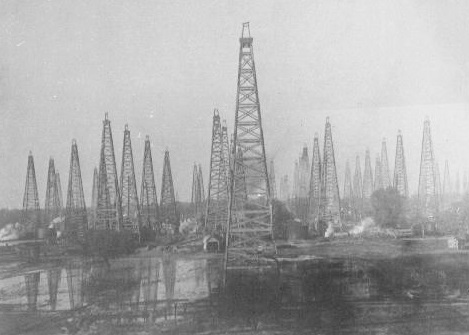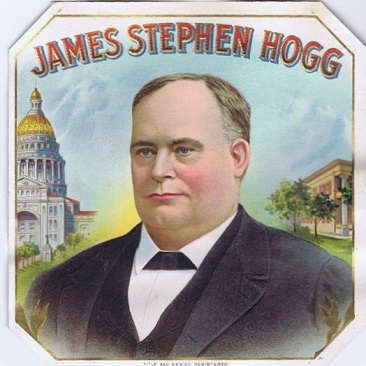Gov. James “Big Jim” Hogg stipulated in his will that mineral rights should not be sold.
In 1917, the Tyndall-Wyoming Oil Company’s No. 1 Hogg well discovered oil south of Houston and ended a streak of dry holes dating back to 1901, when former Texas Governor James S. Hogg first thought oil might be there and leased the land.
The Lone Star State’s 20th governor, “Big Jim” Hogg, died in 1906 without witnessing the Texas drilling boom he helped launch. But his unwavering belief in finding oil in the Gulf Coast’s geologic salt domes would benefit the Texas petroleum industry.

Discovered southwest of Houston in 1917, the 20-square-mile West Columbia oilfield produced more than 119,000 barrels of oil by 1918. Annual production peaked at 12.5 million barrels in 1921.
Tyndall-Wyoming Oil completed its No. 1 Hogg well 50 miles south of Houston. Far to the east at Beaumont, a 1901 oilfield discovery at Spindletop Hill launched the modern petroleum industry. A decade later, wildcatters became interested in Gov. Hogg’s original lease. Many would pursue opportunities in the increasingly prolific West Columbia oilfield of Brazoria County.
Tyndall-Wyoming Oil Company
On September 7, 1917, the Tyndall-Wyoming Oil Company completed a well on the land leased by Gov. Hogg in 1901. The Hogg No. 1 well produced only small amounts of oil, but when the Hogg No. 2 well in January 1918 produced 600 barrels of oil a day, exploration companies and speculators rushed to lease nearby acreage.
The oilfield discovery ended a succession of more than 20 unsuccessful wells dating back to 1901 — when Gov. Hogg leased 4,600 acres for $30,000.

Gov. James Stephen “Big Jim” Hogg (1851 -1906) was the first Texas governor born in Texas. His oil investment paid off a decade after his death.
Gov. Hogg, who served as governor from 1887 to 1891 (and was the first born in Texas), believed the land would someday yield an abundance of petroleum.
The two Tyndall-Wyoming Oil Company wells were part of the giant West Columbia oilfield. The 20-square-mile field produced more than 119,000 barrels of oil in 1918 alone, rivalling the previous year’s “Roaring Ranger” oilfield in North Texas.
Newspaper advertisements appeared across Texas and nationwide. Many of the ads included $10 per share stock promotions enticing investment in the West Columbia oilfield, often with a promise to pay out 75 percent of any net earnings to shareholders. Most of the region’s new and inexperienced exploration companies would not survive in the highly competitive Texas oil patch (see Lucky Jim Oil Company).
Fortunately for his family, Gov. Hogg had stipulated in his will that the mineral rights should not be sold for 15 years after his death.

A busy, muddy street in West Columbia during the drilling boom of the 1920s. The Texas Company (later Texaco) was among the companies that found success in the Brazoria County field.
At its drilling peak, most wildcatters tried and failed in the crowded West Columbia oilfield. As operating and lease costs rose, most ventures did not succeed in raising enough capital. South Texas “poor boy” operations could not compete with larger companies, which could absorb the costs of dry holes and continue drilling.
The Texas Company (later Texaco) — after drilling several dry holes in the West Columbia field — in July 1920 brought in the Abrams No. 1 well, which produced 26,500 barrels a day for six weeks (also see Sour Lake produces Texaco).
The West Columbia field, 50 miles southwest of Houston, “was the youngest of the first rank salt dome oilfields of the Texas-Louisiana coastal region, and at present is the most productive of these fields,” according to the 1921 Bulletin of the American Association of Petroleum Geologists. The West Columbia field reached its peak annual production — 12.5 million barrels of oil — the same year.
Visit the Columbia Historical Museum in West Columbia to learn more about Brazoria County — and Columbia, capital of the Republic of Texas from September 1836 to April 1837.
_______________________
Recommended Reading: Giant Under the Hill: A History of the Spindletop Oil Discovery at Beaumont, Texas, in 1901 (2008); Early Texas Oil: A Photographic History, 1866-1936
(2000). Your Amazon purchase benefits the American Oil & Gas Historical Society. As an Amazon Associate, AOGHS earns a commission from qualifying purchases.
_______________________
The American Oil & Gas Historical Society (AOGHS) preserves U.S. petroleum history. Please become an AOGHS annual supporter and help maintain this energy education website and expand historical research. For more information, contact bawells@aoghs.org. Copyright © 2025 Bruce A. Wells. All rights reserved.
Citation Information – Article Title: “Governor Hogg’s Texas Oil Wells.” Authors: B.A. Wells and K.L. Wells. Website Name: American Oil & Gas Historical Society. URL: https://aoghs.org/petroleum-pioneers/governor-hoggs-texas-oil-wells. Last Updated: August 20, 2025. Original Published Date: June 9, 2016.



